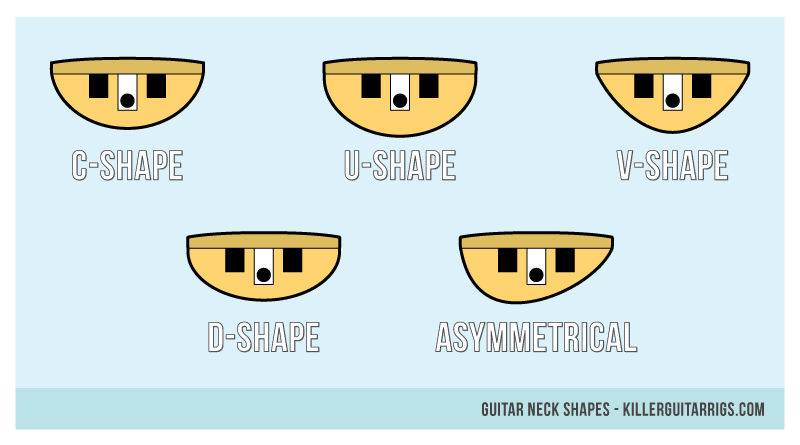Few facets of guitar design have as much impact on the overall comfort and playability as neck shape, and yet, it’s not something that many guides to guitars for newer players ever really covers. As a result, new players become intermediate and advanced, and many go through their playing journeys at a disadvantage because they’re not playing a neck that’s suited to their style and hand size.
Whether you’re shopping for your first guitar, or you’re looking to upgrade, knowing about the various neck shapes and sizes can make it easier for you to progress to the next level of your playing. To make it easy for you, we’ve put together this KillerGuitarRigs Guide to neck shapes – in this guide you’ll learn:
- What Are the Influencing Factors in Neck Profile?
- Most Common Neck Shapes
And much more!
Contents
- What Are the Influencing Factors in Neck Profile?
- Most Common Neck Shapes
- How to Find Which Neck Shape Your Guitar Has
- What is Radius?
- How Does Fretboard Radius Affect Playability?
- What are the Pros and Cons of a Thin Guitar Neck?
- What are the Pros and Cons of a Thick Guitar Neck?
- How to Choose the Right Neck For You?
- Bolt-On vs. Set Neck vs. Neck Through
- Neck shape FAQ
- Final Thoughts on Guitar Neck Shapes
What Are the Influencing Factors in Neck Profile?
When we talk about neck shape, we’re specifically referring to the cross sectional shape of the back of the neck, but this isn’t the only element of the overall picture of the neck, which we refer to as its profile. As well as the shape, we also need to consider some other factors, including depth, width, and fretboard radius, all of which have a profound impact on the guitar’s playability.
Depth
The depth, is as you’d expect, the measurement of the neck’s thickness, from the center of the back, to the top of the fretboard (not to the crown of the fret), measured from the middle of the neck.
Vintage guitars were notorious for baseball bat-like necks. The lack of CNC machinery in vintage guitar production did also mean that inconsistencies were rife, although we do now know that the average thickness of a 50’s Stratocaster neck was around .087” at the nut, and .098” at the 12th. The average thickness on a 59 Les Paul was around .086” at the nut, and .096” at the 12th.
60’s Necks started becoming a lot more tapered, with a more pronounced difference between the depth at the nut and the 12th fret. In the 70s and 80s, with the advent of styles like speed metal, manufacturers started making necks thinner than ever before for their genre specific guitars designed to improve playing speed.
Width
Width is a measure of how wide the fretboard is horizontally from one side to the other. The most commonly accepted point of measurement is at the nut, some people measure from elsewhere, but that’s a debate for another day!
Classical guitars and 12 strings tend to have the widest necks, which can be as wide as 2” and 1.87” respectively. The average electric guitar has a neck width at the nut of around 1.69”. Of course, these are averages, and the width of your neck could be wider or narrower.
Fretboard Radius
Fretboard radius is a measure of the curvature of the fretboard, or, how flat or rounded it is. The higher the number, the flatter the fretboard. This impacts playability in a number of ways, but most notably, insomuch that a flat radius will make it easier to play single notes and will allow for bigger bends, while a tighter radius makes playing chords much easier.
Radius can change within the different sub models of the same guitar, for example, not all Stratocasters are made with the same radius – vintage models, including reissues, relics, and new old stock mostly have pretty tight 7.25” radii. The most common Strats, such as the MIM and USA made Player series have a flatter 9.5” radius. Most Gibsons, including the Les Paul, SG, and even the ES-335 (outside of the custom shop range), tend to have a very flat 12” radius. If you’re looking for eve flatter, take a look at the Strandberg Boden, which has a super flat 20” radius.
Most Common Neck Shapes
Now that we understand more about the whole profile of the neck, now it’s time to learn more about the shapes, what guitars you’ll find them on, and who they’re best suited to.
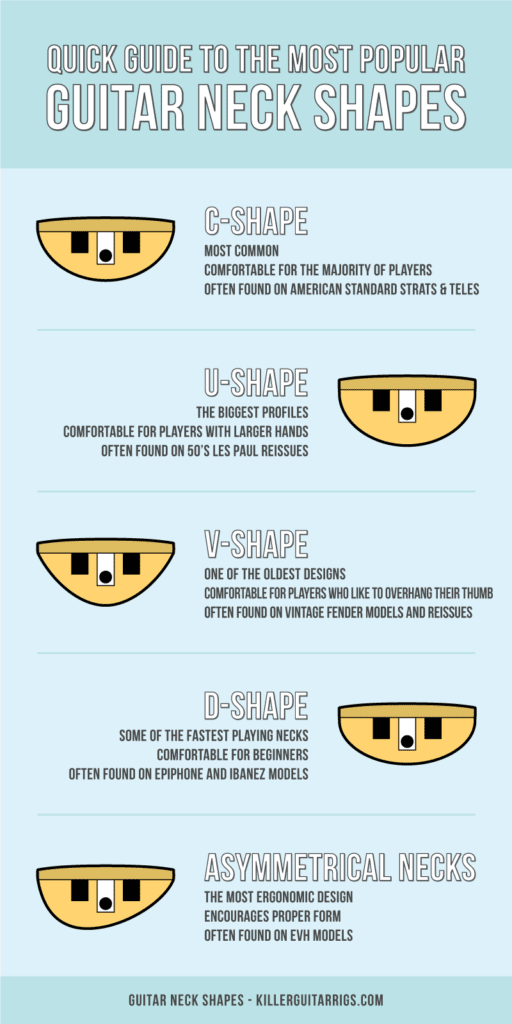
The majority of the shapes are named for how they look in a cross section, although like constellations, sometimes you might need to use your imagination a little!
C Shape
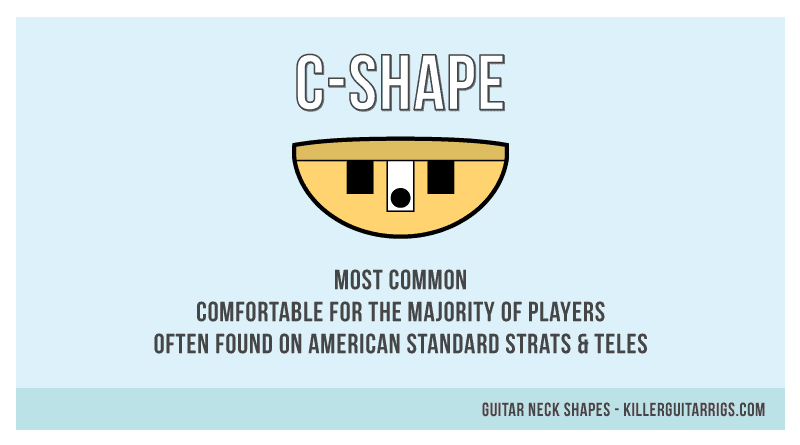
The C shape and its variants are by far the most common neck shapes. They are comfortable for the vast majority of players. The only players who tend to have difficulty with C shaped profiles are those with very large hands.
The C shape really took off in the 80s after Fender switched production to make this shape their primary neck profile for the bulk of their lineup. Fender called this their “Flat Oval”, but we’re using the generic terminology.
Some popular models with C shape necks include the American Standard Strat/Tele, and the ‘61/’59 Gibson SG.
U Shape
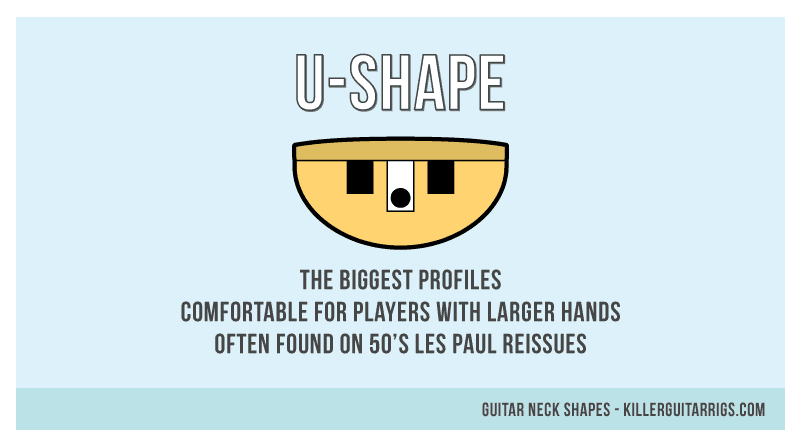
U Shaped necks are some of the biggest and chunkiest you’ll find. The back is much more round than the C shape, which is part of what makes it a much more comfortable option for those with large hands. You will often see these necks being compared to baseball bats due to their huge girth and almost cylindrical shape.
Vintage Fender models and 50’s Gibsons are famed for their use of U shaped necks. As time went on, and necks got slimmer, purists began wanting the authentic feel of these giant necks, and so they’re often fitted to reissue models.
Some popular models with U shape necks include the ’52 Telecaster, and the 50s Les Paul Standard.
V Shape
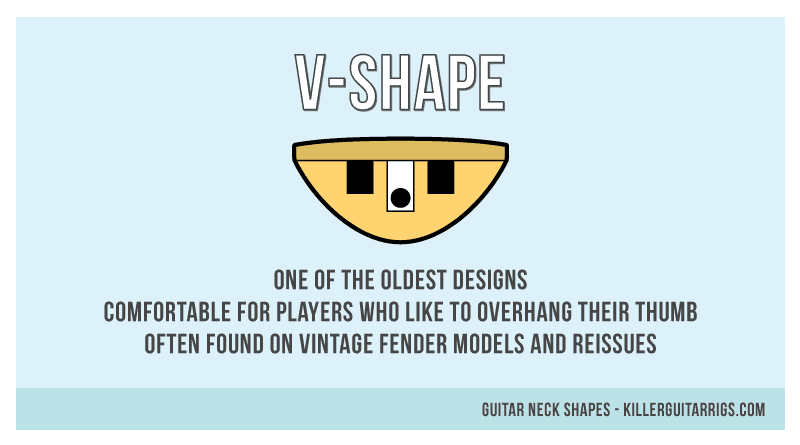
V Shaped necks are some of the oldest designs, and are generally split into either V soft or V hard, with hard having a pointier apex, more like the letter V. These necks are favored by players who prefer having their fret hand thumb resting on the fretboard.
These necks, both soft and hard, have fallen out of favor in recent year, and are mostly found on reissues and custom shop guitars.
Some popular models that have V shaped necks equipped include the 50s Classic Stratocaster, the Eric Clapton Signature Strat, and the American Deluxe V Strat.
D Shape
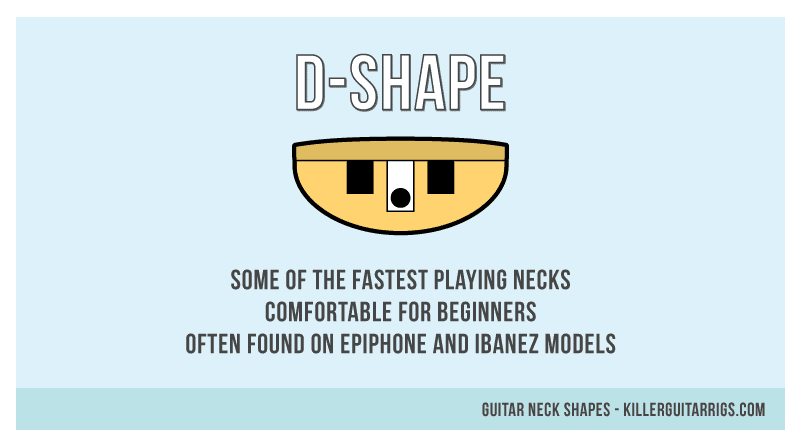
The D shape is a contemporary design that takes the classic C shape, and flattens the edges. In fact, this is one of the flattest designs around, giving it an almost ergonomic feel. Overall, this is a very comfortable neck shape, especially for guitarists who love to play fast passages. In fact, the Ibanez Wizard neck, a neck prized for its lightning fast playing, has a comfortable D shaped neck.
Interestingly, the majority of Epiphones are fitted with a Slim Taper D profile neck. This is primarily because the target market for many Epiphone models is beginners and improving guitarists.
Some popular models with D shape necks include the Ibanez RG series, the Epiphone Sheraton, and many of the Epiphone Les Paul and SG models.
Asymmetrical Necks
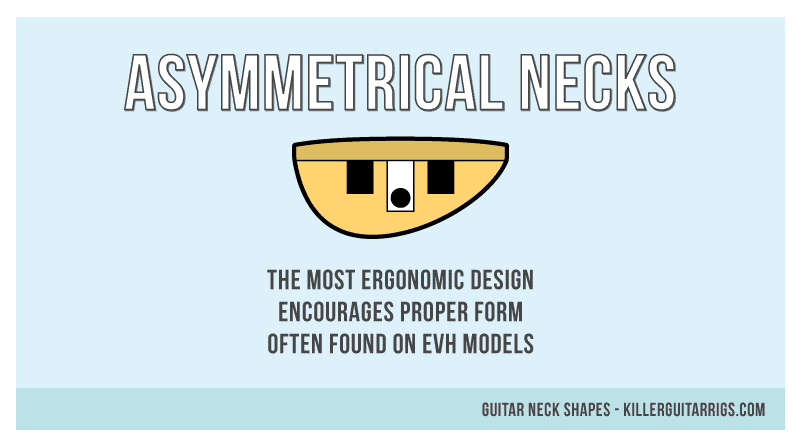
Asymmetrical necks are really the ultimate in ergonomics and comfort when it comes to neck design. One half of the neck is thicker than the other, usually the top side, and the other side gets gradually thinner. Ultimately this results in a stronger grip on the neck while still allowing you to retain dexterity. Think of it as having a cross between a U shape and a D shape.
Some popular models equipped with asymmetrical necks include the EVH Wolfgang standard, and the 2018 Gibson Les Paul HP.
How to Find Which Neck Shape Your Guitar Has
The easiest way to find out what neck shape your guitar uses (if you don’t already know), is to look it up on the manufacturer’s website. If you bought your guitar recently, you can always check Sweetwater, too. On each guitar they sell, they feature a table of specs at the bottom that give you all of the information you’ll need, including neck shape, and even radius.
What is Radius?
As we’ve learned throughout this article, different guitars have different neck shapes and profiles, but up until now, we’ve really only discussed the back of the neck. When it comes to the fretboard, or fingerboard as you might otherwise know it, there is as much, if not more variety available. Rather than being different shapes, though, fretboards have different radii.
The radius of a fretboard is always convex, which means it bulges outwards from the neck. The different fretboard radii are all expressed numerically, just as they would be when measuring the radius of a circle.
Recalling how we measure the radius of a circle, we start in the dead center and draw a line to one edge of the circle’s circumference. The length of that line reflects the radius of the circle. The longer the line, the bigger the circle. If you’re wondering how this relates to a fretboard, now you have to imagine that you can place a cross section of the fretboard itself against the inside of the circle’s circumference. If the number is smaller, the circle is smaller, and therefore the observed curvature of the fretboard is greater. If the radius is larger, the circle is larger, and the fretboard will feel proportionately flatter.
How Does Fretboard Radius Affect Playability?
In a lot of facets of guitar design, the concept of playability is pretty subjective, but, one area that most players tend to agree is a big difference maker, is the radius.
As explained above, the smaller the number, the more noticeable the curvature of the fretboard. Guitars with small radii are widely regarded as being better for chords than they are for single note playing and solos.
Because of the natural curve of our fingers, it’s much easier, and much more comfortable, to make a solid contact on multiple frets at the same time when the fretboard is also curved.
Conversely, when playing solos and other single note runs, we tend to play with more expression, vibratos, bends, and other techniques of that nature. A highly curved fretboard can hinder this type of playing. It’s much easier to bend notes out of pitch accidentally, giving the impression of poor intonation, and especially with large bends, notes can “choke out”. On a flatter fretboard, chords are more challenging to hold down, but fast players and lead guitarists can achieve much better tone.
What are the Pros and Cons of a Thin Guitar Neck?
Thin necks are prized by fast players and beginners alike. They are comfortable for most players and tend to make it easier to get up and down the fretboard. So the question is, why doesn’t every player want a thin neck? As with everything there are some pros and cons.
Pros:
As mentioned, thin necks make it much easier to reach around the fretboard, this can ultimately improve your playing speed.
Beginners will find that a thin neck makes it easier to reach for more complex chords, too, which will improve tone over a thick necked guitar that they struggle to make proper contact on.
Cons:
Larger players, especially those with a heavy handed playing style, might find that they literally bend the guitar out of pitch with a thin neck.
While thin necks can make it easier to play fast and reach around the neck, they’re typically less ergonomic. This can lead to increased hand fatigue and even cramps after long periods of playing.
Thin necks are also more susceptible to unwanted bow. This can limit players to using only lighter gauge strings to prevent excess tension causing action or intonation issues.
What are the Pros and Cons of a Thick Guitar Neck?
Because we’re all different, some players really love the feel of a fat neck. But, as with thin necks, there are drawbacks that can (for some) outweigh the advantages.
Pros:
The ergonomics of a thick neck can be superior for some players. These necks fill the palm and reduce the strain that can be experienced by overextending around a thinner neck.
Thick necks are heavier, which can improve the overall balance of the guitar. The additional mass vs a thin neck can also help to prolong sustain and ultimately improve tone.
Cons:
Beginners or players with small hands may find it challenging to reach for certain chords, particularly barre chords.
How to Choose the Right Neck For You?
When it comes to choosing the right neck you’ll have to lean on whatever experience (or lack thereof) that you have. More seasoned guitarists will likely already have a feel for what they like based on the guitars they’ve owned or played throughout their time.
Entry level guitars aimed at newer players aren’t only entry level because of their price tag. In many cases they’re made with thinner necks that can assist in the necessary development of skills and techniques before progressing on to more specialist profiles like the ultra thin Ibanez Wizard neck, or the huge ‘50s Les Paul necks.
If you aren’t planning to buy an entry level guitar, you should always play a range of makes and models before deciding. If you’re buying something based on what your favorite players use, that’s fine, but remember, their experience (and physical anatomy) will differ from yours, so don’t rush to buy anything based on that alone, especially if it will be your only guitar.
When testing, play some chords, some scales, and try to move up and down the whole neck. Play bends and vibratos, even if it’s not your usual style, it’s all important to make sure you don’t end up with a guitar that ends up being restrictive.
Bolt-On vs. Set Neck vs. Neck Through
Bolt On
Bolt on necks are common on many different electric guitars, and even some acoustics. The basic principle involves having a channel routed into the back of the body to accommodate the base of the neck, and then 3 or more bolts are run through both the neck and the body to join them. On the back of the neck there is normally a plate that helps to distribute the pressure of the bolts over a wider area, simultaneously preventing damage to the wood from the bolts, and providing a more secure fitment.
Bolt on necks tend to be the cheapest of all the necks to mass produce and equip on the guitar. Especially in the age of CNC machines, they can easily be replicated with a high degree of accuracy by machines alone, leading to greater consistency, and ultimately making cheaper guitars better.
Of course, bolt on necks aren’t all about cost saving or reducing labor hours. In fact, some of the world’s most sought after guitars have bolt on necks, some of the most famous being the Stratocaster and the Telecaster. Many people find that having a bolt on neck can improve attack and provide a brighter tone.
Other benefits include ease of replacement and adjustment. If the unthinkable happens and the neck snaps on a set neck or neck through guitar, that is potentially the end of the guitar. Best case scenario it’s a very pricey repair. With a bolt on neck, simply unbolt the broken part, and screw on a new one. Bolt ons also allow for the application of shims, which can be used to make minor adjustments to the angle of the neck. This is particularly useful if you’re having difficulty adjusting the action of the guitar at the bridge end.
Set Neck
Set neck guitars are another of the more common designs, although probably less so than bolt on. The manufacture of set neck guitars is a much more in depth procedure and requires more luthiery skill than the simple bolt on. Like a bolt on, a channel is routed in the back of the body of the guitar, but instead of securing with bolts, it is secured with either a dovetail or mortise and tenon joint, and adhesive. Once the neck is in place and the glue is applied, the assembly is clamped for a number of days to ensure a proper connection.
Some manufacturers use set necks almost exclusively on their instruments, and as a result, those guitars have become synonymous with the set neck. Most of Gibson’s models, with a few exceptions such as the Sonex, and Marauder have always been made with the set neck technique, and many guitarists won’t consider instruments with any other neck type a true representation of those respective models.
Guitars with set necks are usually regarded for their warm tone, and increased sustain over their bolt on counterparts. In some cases, access to the upper frets is also improved.
Neck Through
Neck through guitars aren’t rare, but they’re probably the least common of the 3 major neck designs. With a neck through design, the piece of wood used for the neck actually continues through the entire length of the body and forms the literal core of the guitar. The wings are then joined to the sides to complete construction.
Of all of the neck designs, neck through is by far the most complicated (and most expensive) to produce. For this reason, it’s a design normally only found on high end, and boutique guitars.
Like set neck designs, neck through guitars offer easy access to upper frets, but to an even greater degree. Because there is no heel required to stabilize the neck, the neck itself maintains its profile all the way to the body. It’s often said that neck through designs boast some of the best intonation due to their neck strength and offer unparalleled sustain.
Of course, with those great benefits, come some serious downsides. A neck break can be completely unrecoverable in many cases. Even with set necks, it’s possible to replace the neck, albeit with more difficulty than a bolt on, but because the neck forms part of the guitar’s core in a neck through, most breaks, especially around the upper frets, simply cannot be repaired.
Neck shape FAQ
Does neck shape matter?
Simply put, yes! Neck shape matters a lot when it comes to guitar playability. It doesn’t have a particularly noticeable impact on tone or sound on its own, but, by using the appropriate neck profile for your ability, and hand physiology, you can make big improvements to your technique, which will have the knock on effect of improving tone.
What is the best guitar neck shape?
Holistically speaking, there isn’t really such a thing as the best guitar neck shape, even when honing into specific genres, it’s even hard to say that one style is the best neck for metal, for example. Using the guide above, you can find the best neck shape for you, but remember what works for you might feel awful for another player, even one who plays the same songs in the same genre.
Are wide neck guitars easier to play?
Wide necks are easier to play in some cases. With a wider neck comes greater string separation. If you play highly technical pieces, having the strings spaced further apart can result in fewer mis-fretted notes. On the other hand, if you’re a younger player, or you have small hands, you might struggle to play barre chords or even reach for single notes on a wide necked guitar.
What does a “fast neck” mean?
If a guitar has a fast neck, this means it has been intentionally designed and set up to play fast. Fast necks tend to be thin, and while not always the case, they most often have a D profile and a large radius. This combo provides a relatively flat back, and an almost perfectly flat fretboard, resulting in easy access to the upper end of the fretboard, and better control over bends.
Another component of a fast neck is the finish. Fast necks tend to have satin finishes, and in some cases may be untreated altogether. Glossy finishes are super smooth, and while logic tells us that this should mean easy gliding, it’s quite the opposite. Think of a gloss finish like a slick tire on a race car; it has a much bigger surface area, and in most cases will grip harder than a rougher surface – so trying to move your hand up and down quickly will actually be more difficult.
What neck shape does a Les Paul have?
Les Pauls come in a number of different neck shapes depending on the specific model you’re looking at. Even if you discount the Les Paul style guitars made by other brands, and focus solely on Gibson and Epiphone, there are differences.
Some of the most common Les Paul necks include:
Vintage 50s – these are “rounded”, or C shaped necks, famed for their extreme girth.
Vintage 60s – these are known in Gibson/Epiphone circles as “Slim Taper”, which to the rest of the guitar world is a D shape. They are very comfortable and fast playing.
Slim Taper Asymmetrical – these are, size-wise, similar to the 60s profile, but include an ergonomic twist to further improve comfort and fretboard access across the entire neck.
What type of guitar neck is best for small hands?
If, like many other players with smaller hands, you’re struggling to find a comfortable guitar, make sure you’re looking specifically at guitars with narrow nuts and slim neck profiles. With smaller hands, the fatigue issues that can plague larger players on smaller necks aren’t really a factor, so simply having a neck that comfortably fits your hand and allows you to effectively stretch as far over the fretboard as you need to is the priority. D profiles or asymmetrical necks are the most likely to be comfortable in these cases.
Final Thoughts on Guitar Neck Shapes
We hope you’ve learned a thing or two about the influence that the neck shape has on your guitar. It’s not going to affect tone, intonation, sustain, or any audible facet, but having the right neck for your hand shape and size, as well as your ability level, is going to help you to play better and progress faster.
If you take anything away from this guide, make sure that it’s asking about, or researching the neck on your next guitar, especially if you buy sight unseen online. A comfortable neck is more often than not the difference between a beloved guitar that gets a lot of play time, and a guitar you regret purchasing.
Check out these other articles you might like:

